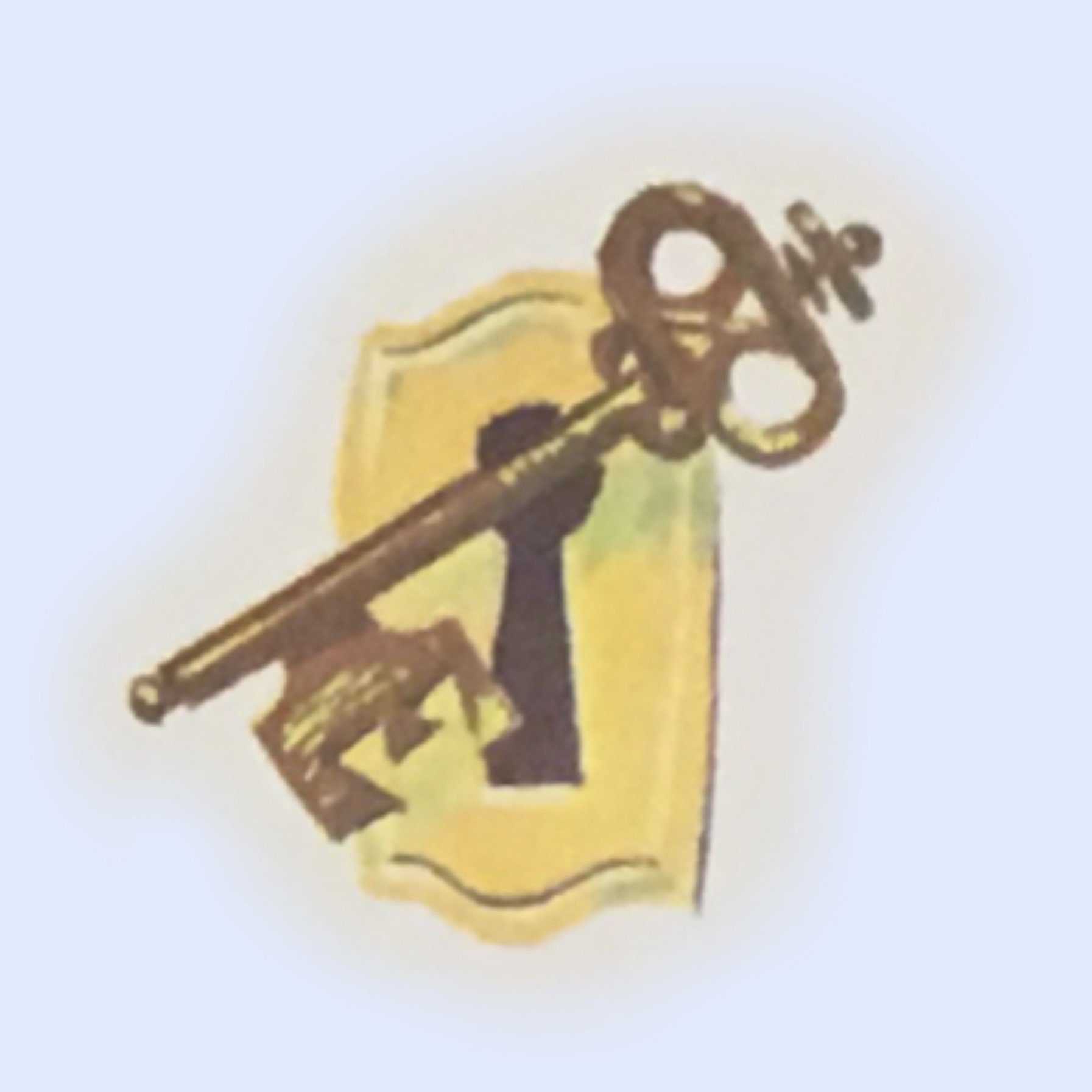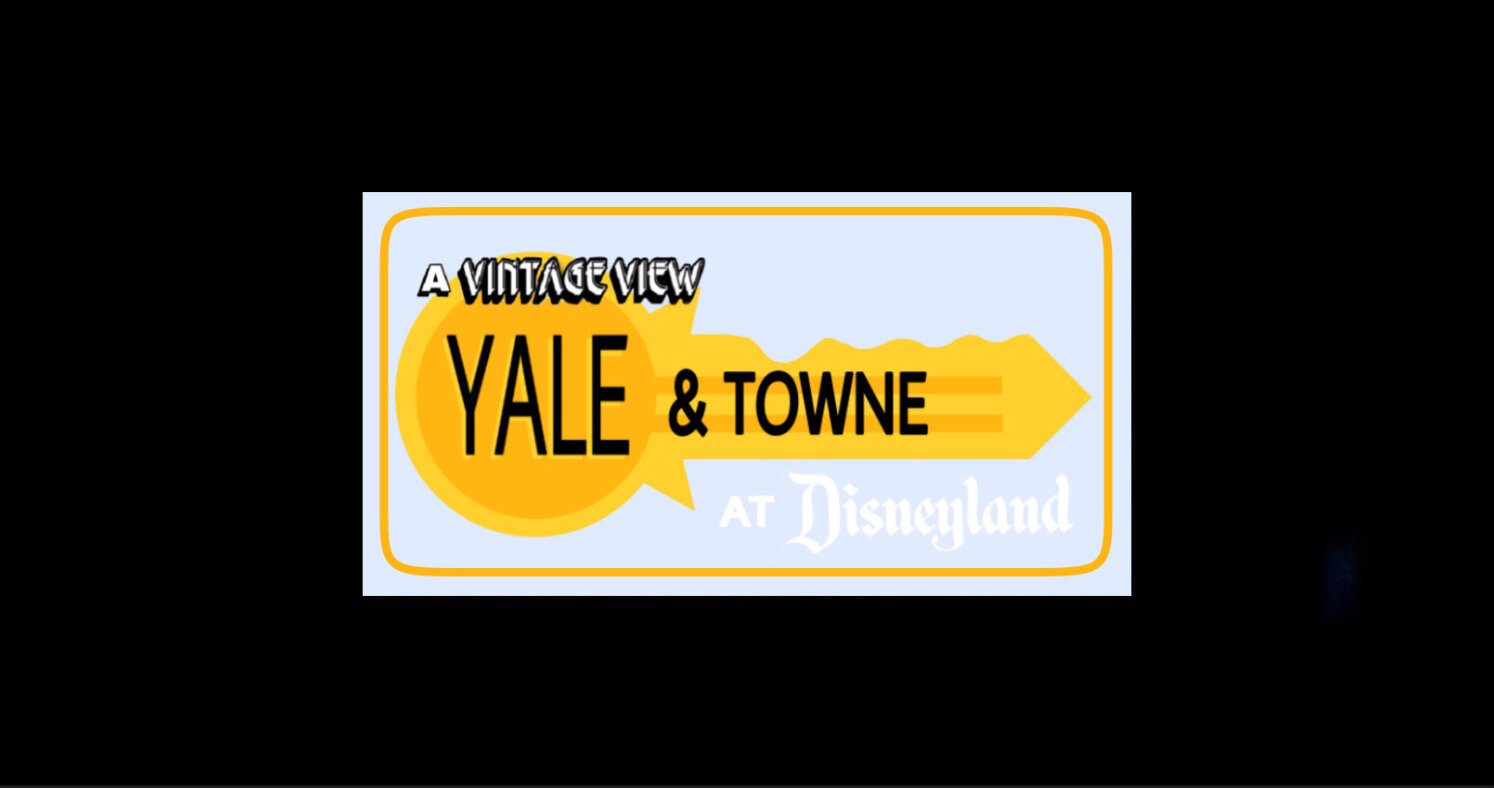YALE TOWNE & LOCK SHOP
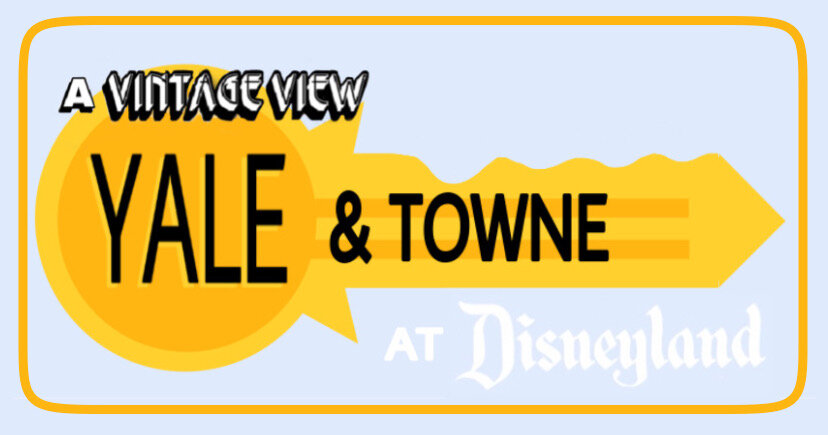
(July 17, 1955 - 1964)
During 1954, Walt was searching for Participants (preferably, “old reliable firms, which have been in business fifty years or more”) to lease shop and restaurant spaces at Disneyland, and help generate the necessary capital to fund construction of Disneyland. By July 1, 1954, George Whitney of Disneyland, Inc. directed Amusements, with Ron Miller overseeing analysis, philosophy, capacities, planning, operator training, and amusement procurement. By July 1, 1954, Russel Tippett of Disneyland Inc. Advertising oversaw Exhibitor’s Space Sales and Lease Agreements. In a synergistic relationship, the companies (in turn) could sell their products and advertise their corporate names in the Park. Disneyland Participant Corporate Sponsors were carefully selected. High quality, long term corporate sponsors would provide incremental income that enabled Disneyland to enhance its show and attractions, offset some operating expenses, and capitalize on marketing opportunities.
Years later in 1958, Bank of America appraisers figured of the total income received from leases, 16.02% was derived from the selling of advertising rights and 40.12% from the leasing of space to concerns whose main reason for occupancy is for advertising purposes. The remaining 43.86% of the lease income was derived from stores that sell various products and food. Clearly these lessees would provide a certain level of income.
Yale Lock Manufacturing Company (founded in 1869, by Linus Yale Jr. and Henry Towne) was one of the United States’ “old reliable firms, which have been in business fifty years or more. Here they can show how they started and reproduce their first place of business.” [Disneyland Prospectus, 1954] As Walt described to Bob Thomas (of Associated Press), “some industries will have exhibits, but all of them must be in keeping with the era.”
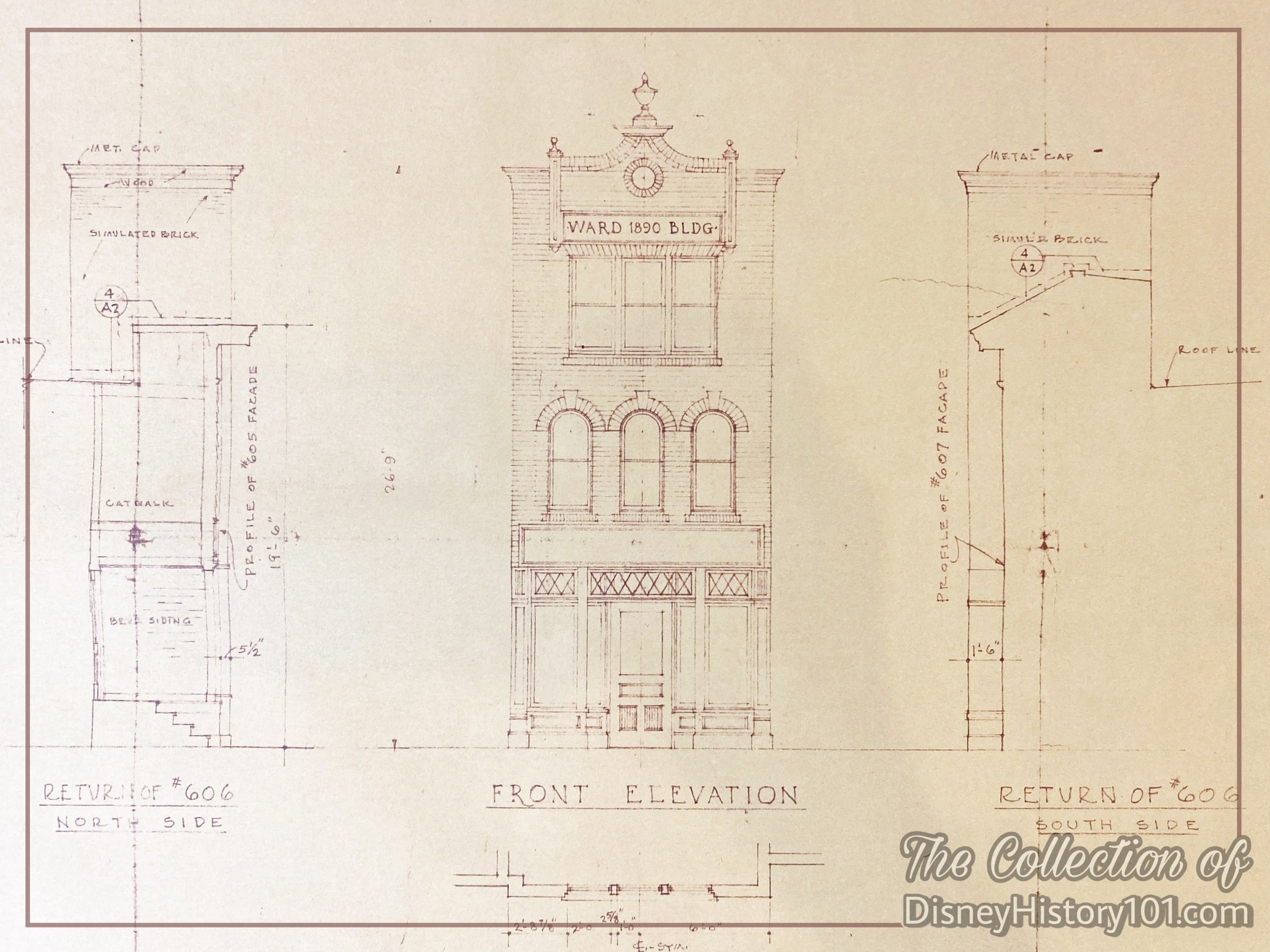
“1/4 Scale Plans & Elevations” for the 600 Block of Main Street produced by WEDEnterprises, Inc.
“Design”
In designing the Yale Lock Shop and the rest of Main Street, there was a lack of 20th-century architectural reference material at the time of the conception of Disneyland, so some Walt Disney Studio artist (Ward Kimball) made the contribution of rare books of drawings from his own collection. “Disneyland is unique in that some of the world's foremost creative artists and architects control all design at Disneyland.“ As early as 1953, artists Harper Goff, Herb Ryman, Sam McKim, Dale Hennesy, Harry Johnson (who was good friends with Herb Ryman, and whose designs were most influential), and others created many conceptual pieces for Main Street and it’s shops. Herb Ryman (who was an Illinois native, the same as Walt), “had a lot in common while discussing and developing Main Street” for the midwest visitors, according to “A Brush with Disney” by Herbert Ryman, page 148. Herb Ryman would create the first “Schematic Aerial View” over Disneyland (including Main Street USA), originally produced September 26 & 27, 1953.
Other contributing artists were model-maker Fred Joerger (who was hired c.1953 to craft the “Barber Shop Quartet” show for “Project Little Man” of “Walt Disney’s Disneyland”) and Wathel Rogers were instrumental in translating the two-dimensional artwork into detailed miniature models of Main Street. Their models explored the various dimensional relationships, site-lines, flow patterns, ergonomics, and visual appeal to convey the desired creative intent. On a leave of absence in 1954, Chuck Myall also joined WED to help create some of the Main Street facades.
Architectural drawings helped define all designs, production and construction strategies, costs, schedule, and resource requirements. A related lesser-known “Frock” is of particular note, for preparing the architectural elevation and floor plan drawings for the 600 Block of Main Street by February 19, 1955. His drawings were soon checked (by a “GMB”) and approved (by two individuals).
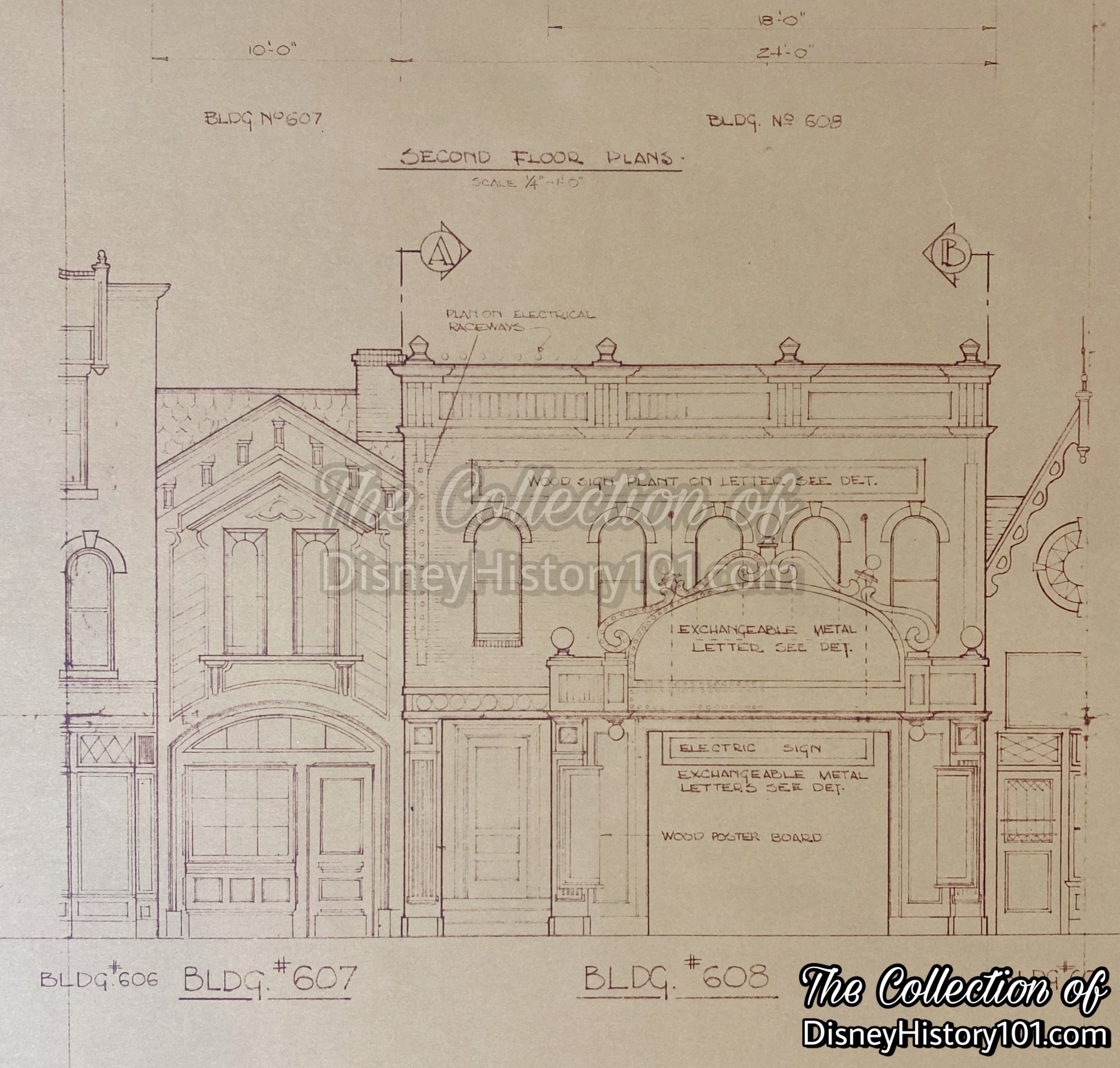
“1/4 Scale Plans & Elevations” for the 600 Block of Main Street produced by WEDEnterprises, Inc. depict the entrance to Yale (Bldg. 607), next door to Main Street Cinema.
Drawn by Dean Tavoularis.
“Architectural Designs by Lessees”
Disneyland, Inc. printed materials for Lessees detailing specifications for architectural designs of exhibit spaces. These were revised by March 16, 1955 and issued to Lessees.
All of the interior architectural drawings were done by competent registered architects or an approved display house of the lessee's choice. All of the designs submitted by the lessee's architect, whether for buildings or construction of interiors in DISNEYLAND, were approved as to the theme and general plan of DISNEYLAND as established by WED Enterprises, Inc.
Three sets of preliminary drawings were furnished DISNEYLAND, Inc. as soon as possible after signing of the lease. Two sets were retained by DISNEYLAND and one set was returned to the lessee’s architect with any revisions noted thereon and stamped “APPROVAL TO PROCEED TO FINAL DESIGN.” This stamp when properly signed and dated constituted the lessee’s authority to proceed with the final drawings.
The Lessees revised their final drawings to incorporate any revisions noted on the approved preliminary drawings, and submitted three sets of the revised drawings to DISNEYLAND. One set was returned to the lessee’s architect and any revisions noted thereon are to be incorporated on the original drawings. When the lessee had incorporated the final revisions on the drawings, two sets of transparent ozalids were forwarded to DISNEYLAND for approval. DISNEYLAND would stamp both sets “FINAL DESIGN APPROVED” and “LESSEE’S CONTRACT DRAWINGS”, and return one set to the lessee who could then release drawings for bid and/or construction.
“Construction”
“When the giant earth-moving undertaking was completed, the building crews took over. Soon, the rat-tat-tat of riveters was shattering the air, and sparks were flying from welders’ torches as the steel frameworks, capable of withstanding the ravages of time and the elements rose above the newly formed ground. While carpenters hammered and masons laid row upon row of brick and stone and mortar, the permanent buildings began to take shape and form,” according to “The Disneyland Story” published 1955. One of the first buildings to be constructed was the Main Street Opera House, which was used as the Mill. Here, the woodwork of Disneyland was generated - from the functional to the aesthetic! Approximately three and one-half million board feet of lumber went into the Park’s construction. Much of the wood was processed here by McNeil Construction (which formerly constructed Walt Disney Studio sound stages in 1947 and 1953), and under the direction of George Mills Sr. (the Prime General Contractor and Mill Foreman). Then, under the direction of Joe Fowler (Construction Supervisor), as well as Charles Alexander and Ray Conway (Construction Field Supervisors), the lumber was soon fashioned into the framing belonging to the very first buildings constructed at Disneyland - primarily the Main Street Complexes (on each side of the street). This included Main Street Building #600 and the 329 square foot shop to be occupied by Yale & Towne.
F.M. Franz, manager of operations for MeNeil Construction expressed: "We feel sure there has never been anything built like this in Southern California, or elsewhere in the United States. Many of the items were constructed from artist’s sketches.” In constructing each building, a concrete foundation and slab floors were prepared, followed by wood frame construction (while store units would have a combination wood and rigid steel frame). ”The first fabricated steel for the Main Street buildings arrived November 8 and was erected,” according to the narrator of “Disneyland - The Park,” a Disneyland anthology television series excerpt, first aired 1957 and Disneyland LINE (November 22, 1979).
According to inserts published in area newspapers during July of 1955, Disney buildings were roofed by Pioneer Roof & Shingle Company (then located at 608 Mateo Street, Los Angeles, California; 7522 Westminster Avenue, Westminster, California). The roof covering was a variable, dependent on the architectural design.
Newbery Electric Corporation gave electricity to Disneyland. “The electrical installations were supervised by Roy J. Gruendler, manager of Newbery's Orange County district office located at 1335 Santiago Ave, Santa Ana.”
The building (as each on Main Street U.S.A.) possessed complete fire sprinkling systems. By June 30, 1955, related Disneyland Site Work Fire Protection Utilities Plot Plans were prepared for Disneyland Inc., by J.E. Thomasson of WED Enterprises Inc.
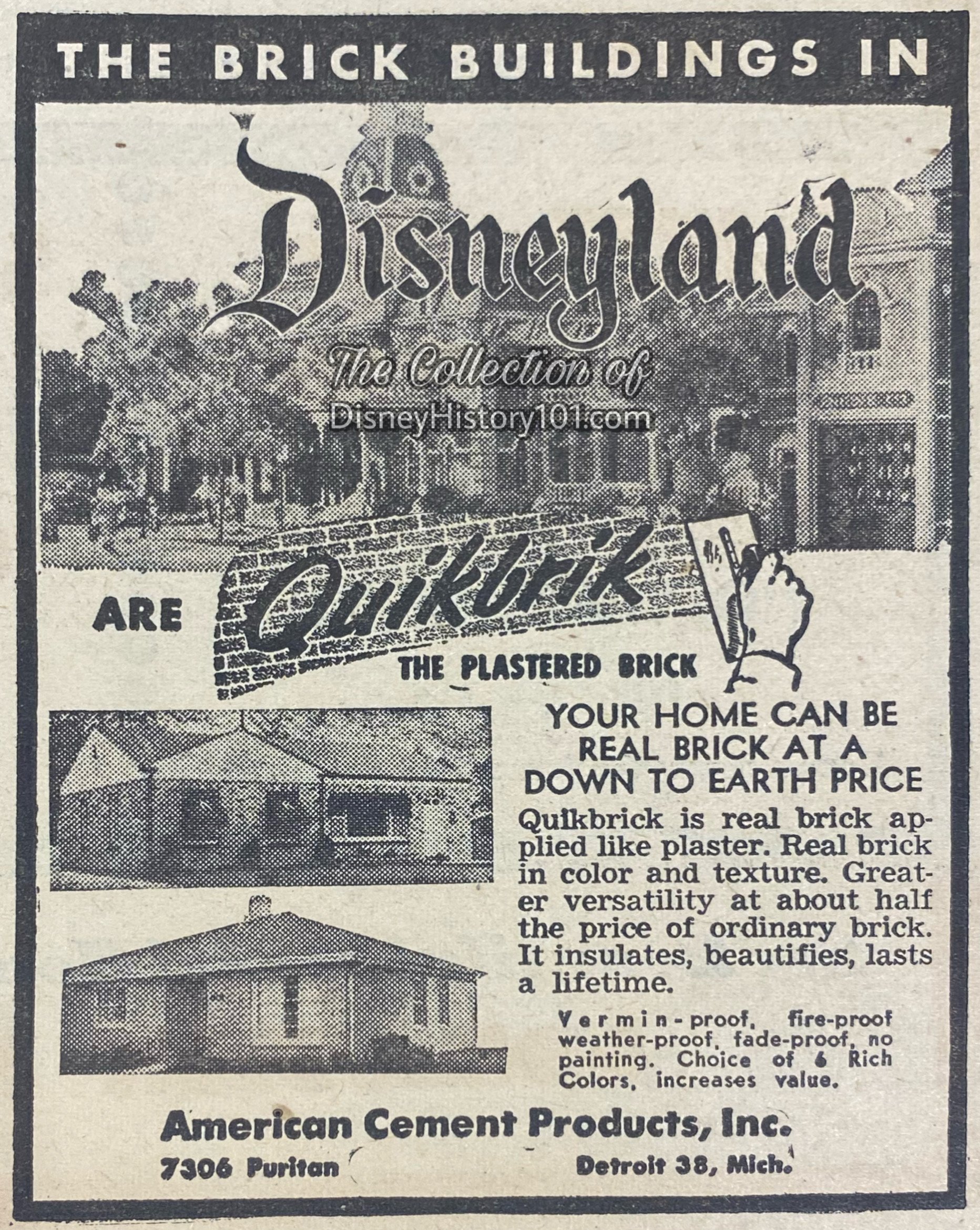
Larson Brothers Plastering Company of San Diego was a proud part of Disneyland. The company crafted the ornamental plastering and all brick used at Disneyland (including their amazing new plastered brick veneer). The versatile Quikbrick (real colorful and textural brick applied like plaster) was about half the price of ordinary brick. It insulated, beautified, and was meant to “last a lifetime.” It was used on the facade.
Ray Van de Warker (who became Department Manager of Office Support Services) remembered the distinct look of Main Street when he first came to work. “Main Street was dirt. Some of the buildings didn’t even have facades on.” (to Disneyland LINE, Vol.25, No.28, published July 16th, 1993). But soon the storefronts were erected. According to Florabel Muir (of the New York Daily News) divulged after a pre-opening (July 9th) tour by Walt, “the buildings are not false fronts as are seen on every studio backlot in Hollywood… Walking down Main Street, I saw a photographer’s shop, ice cream parlor, penny arcade, bakery, drug store, grocery and a butcher shop. These stores will be operated as concessions by well known U.S. firms. Swift & Co., for instance, will run the butcher shop, though instead of real pork, beef and lamb, they’ll sell candy imitations of their products.”
As with all of Disneyland’s Opening-Day landmarks, rides, and attractions, small local businesses provided materials, labor, and skills. Steel was provided by Triangle Steel & Supply Company (of Los Angeles).
All fixtures were placed in their correct motif and many light fixtures of Disneyland were authentic antiques. Newbery Electric Corporation “gave electricity to Disneyland,” Southern Counties Gas Company provided economical and clean gas, buildings were roofed by Pioneer Roof and Shingle Company (of Westminster, California), Mc Neil Construction Company provided labor, Evans and Reeves Landscaping Inc. (of West Los Angeles) achieved“the perfect landscape for Disneyland,” and so forth.
The buildings of Main Street (Yale & Towne Lock Shop included) were soon after described by an appraiser as “all very ornate, with variable embellishments. The basic construction, consists of concrete foundation and slab floors, wood frame construction, (store units also have a combination rigid steel frame) roof covering is variable, being dependant on architectural design. All buildings have complete fire sprinkling systems.” “Some of the cresting and railing to be seen in… Main Street came from old plantations in Nashville and Memphis, Tennessee. Other furnishings came from San Francisco, Oakland and Sacramento, dating back to the ‘49 gold rush days,” according to an article published in The Disneyland News (Vol.1 - No.1 ; July of 1955). [“Building A Dream”, Disneyland Public Relations Department]
As of June 2, 1955, C.V. Wood Jr. sent an Inter-Office Memorandum to Walt Disney regarding the best estimates that could be obtained at the time regarding the completion status of individual sections of the Park and Opening Day. C.V. wrote: “Building #606 - Yale & Towne: This one will be very close but we feel it will be completed. Electric Signs: All are in work - with the exception of the shoe store and the Bank of America, all will be completed.“
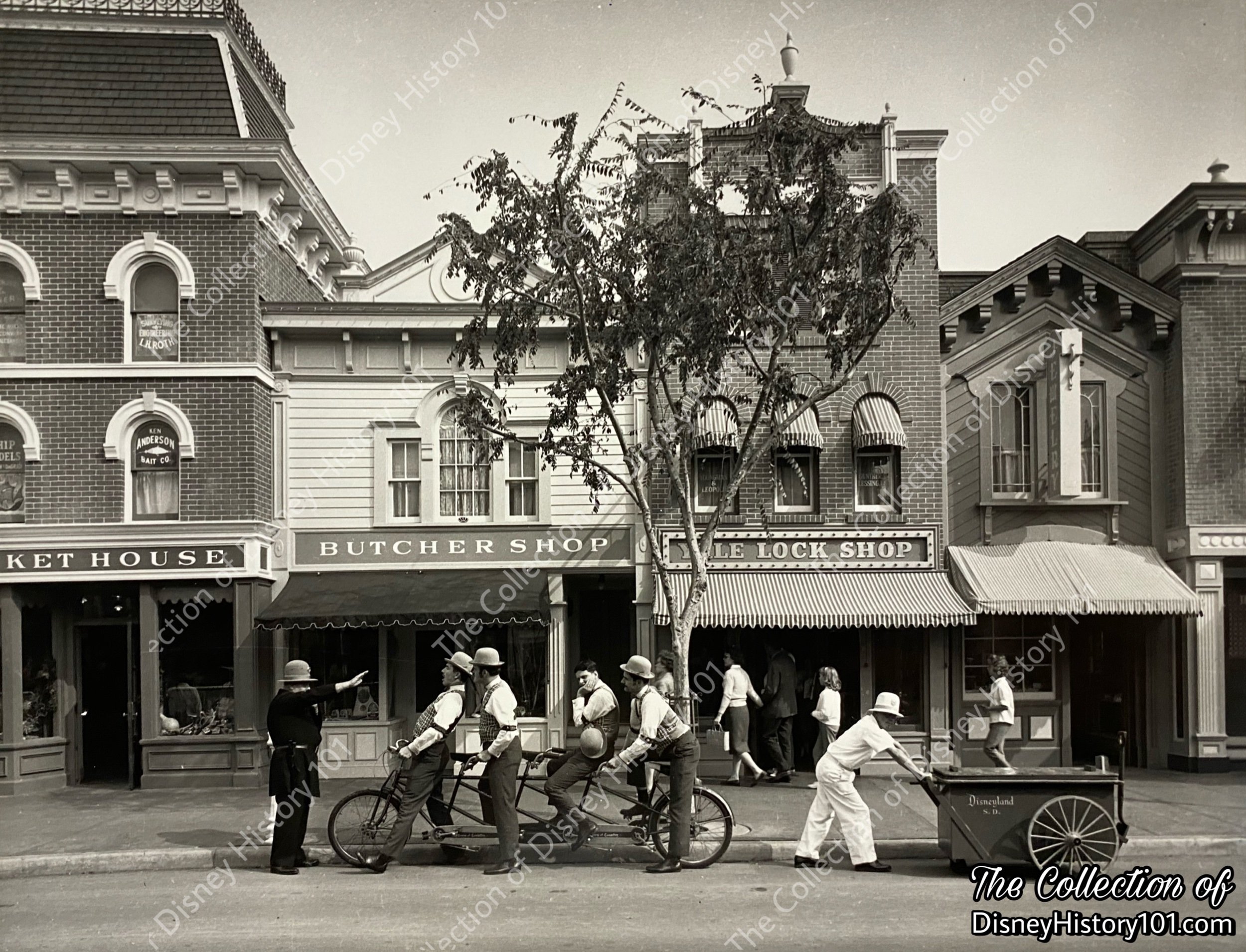
Press Release Photo; ©️Walt Disney Productions.
“Grand Opening”
Disneyland was a “new path” to explore for both Walt and Yale. The Yale and Towne Manufacturing Company attraction opened the Yale & Towne Lock Shop, at 606 Main Street, on Press Preview Day, July 17th, 1955. On that very Press Preview Day, the Yale brand was well represented at Disneyland. Yale tractors carried cameras and cameramen. Fess Parker bestowed a large Key to Disneyland (manufactured by Yale) upon Vice President Richard Nixon, Mrs. Nixon, and their daughters. The Yale & Towne Shop issued gold-plated Disneyland Souvenir Keys to members of the press and their families on July 17th, 1955.
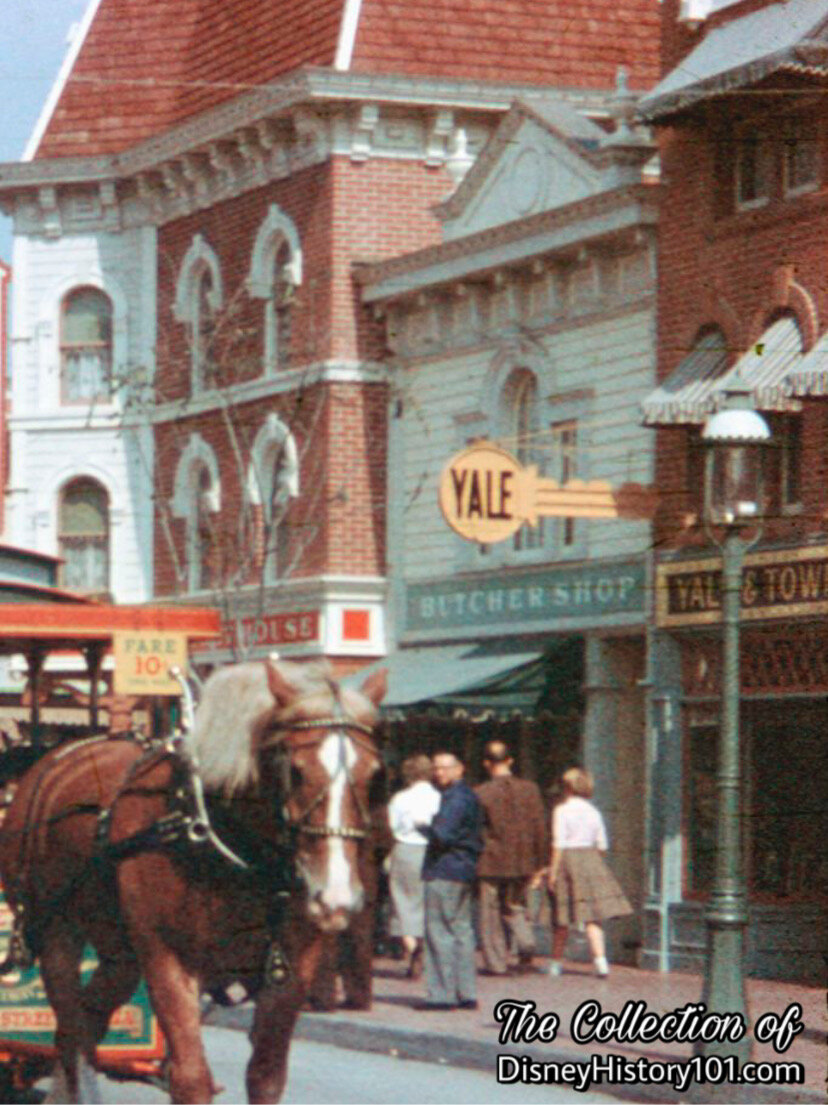
Look for the giant key over the YALE & Towne Shop.

YALE & Towne Shop
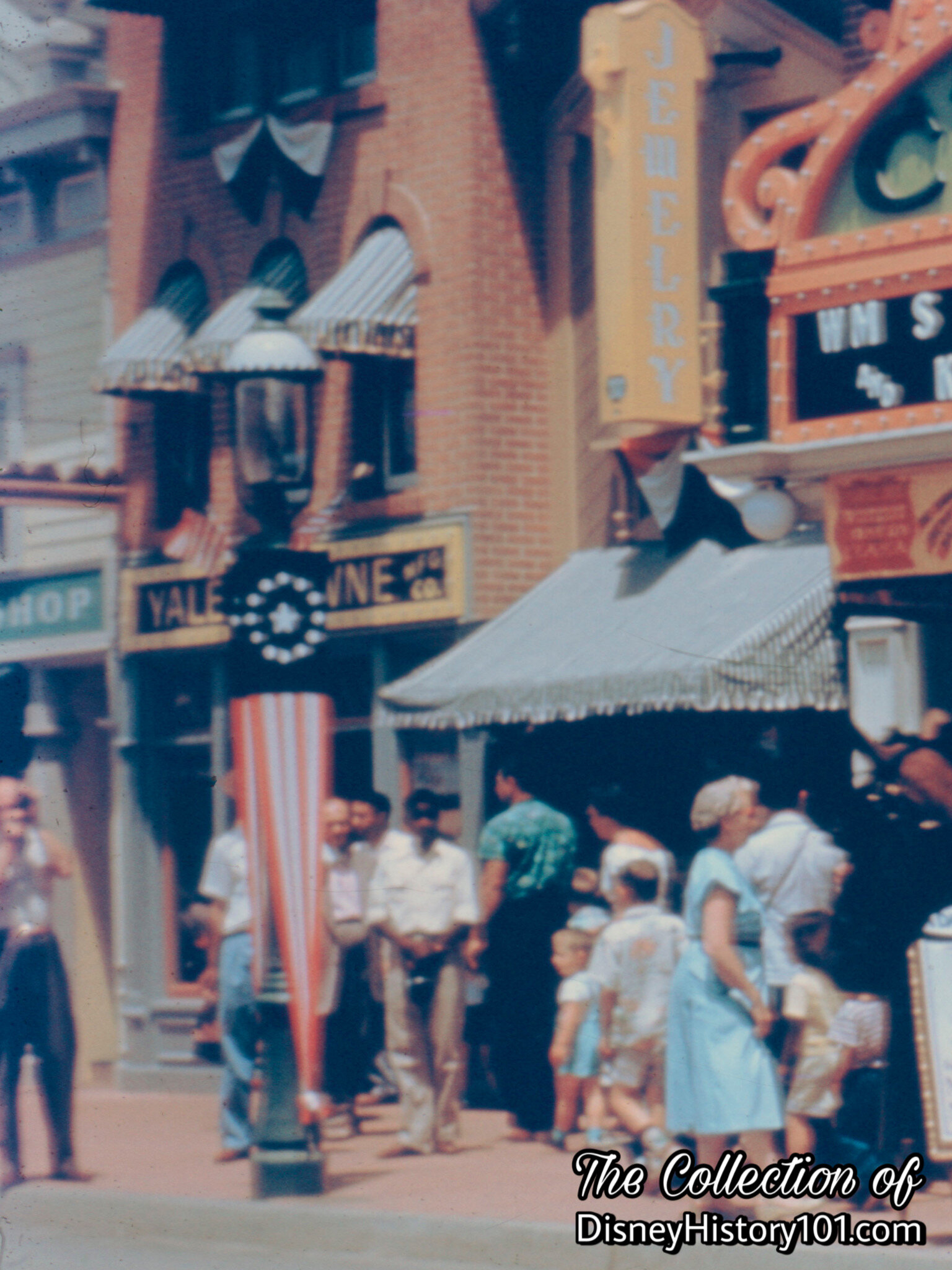
YALE & Towne Shop
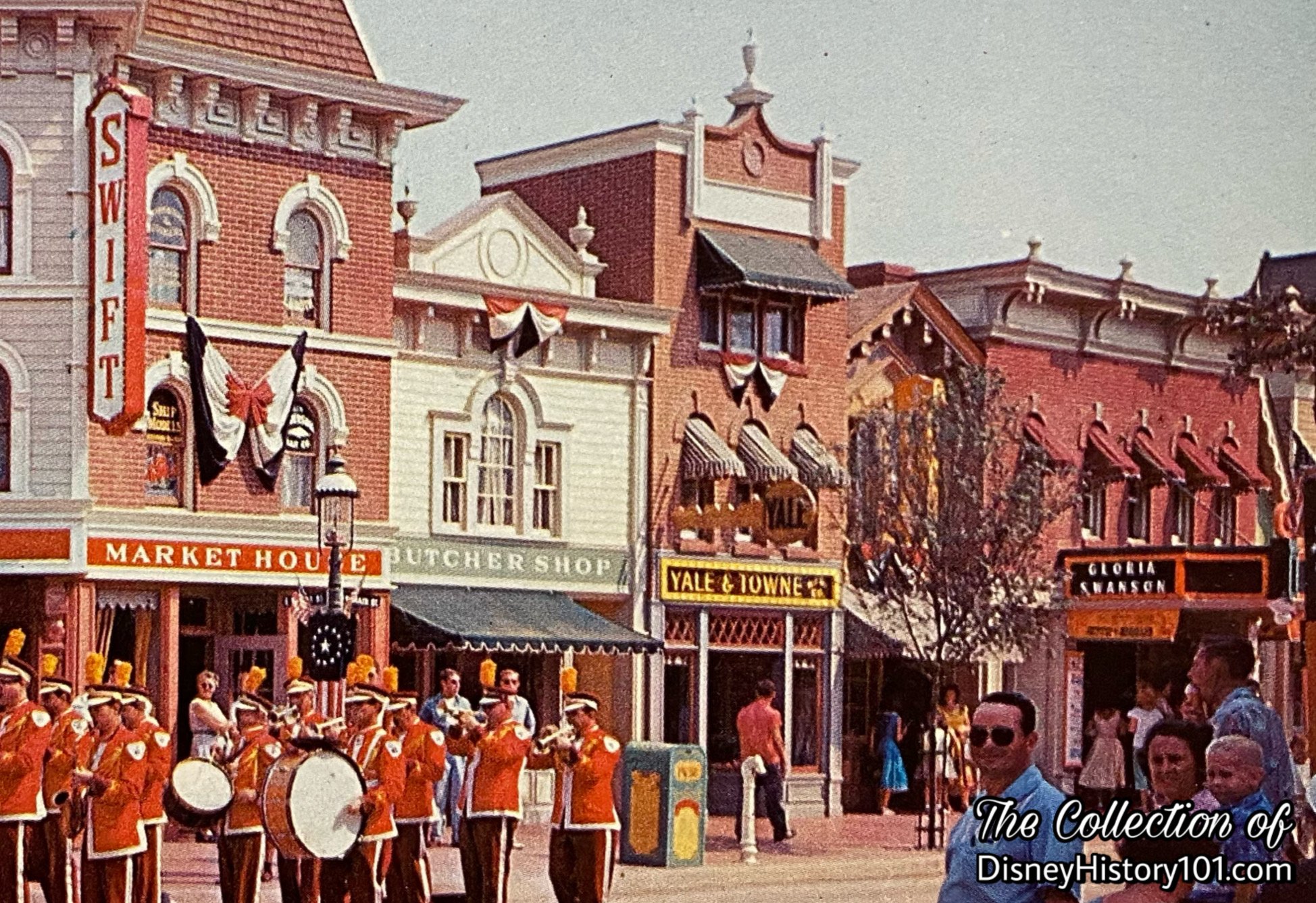
Spot the Yale Towne & Lock in the Disneyland Souvenir Book in Natural Color, c.1955.
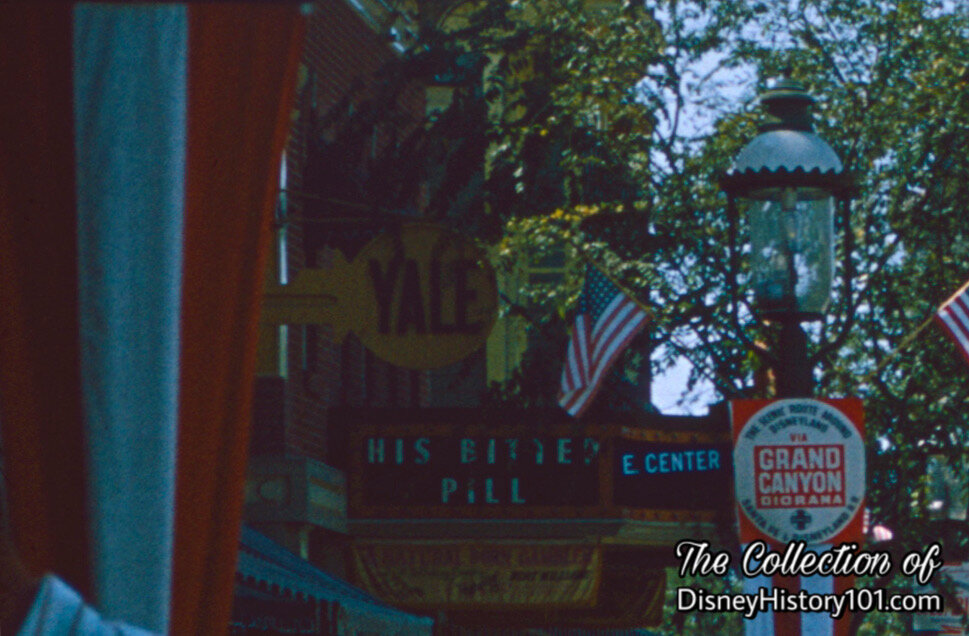
Yale & Towne Lock Shop, 1958.
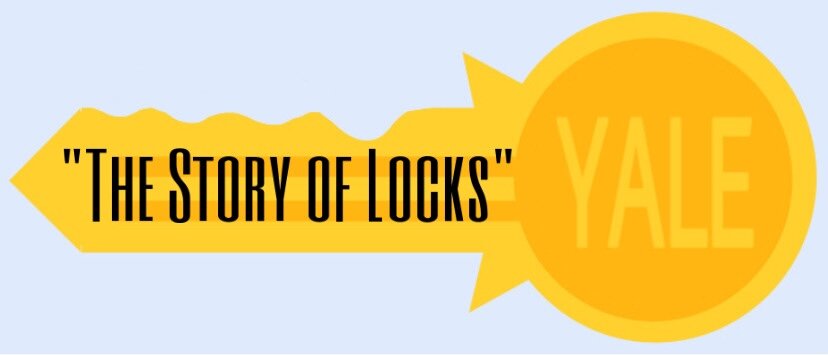
Now, “Disneyland is a place to have fun… and with the fun it is a place where you can learn… a place for people to find happiness and knowledge,” according to “Disneyland, U.S.A.” (published 1958, for potential Participants). Inside the relatively small 329 square-foot Yale & Towne Lock Shop was “The Story of Locks” exhibit, which featured a “complete display of the locksmith’s art” - both antique and modern locks. In short this was an exhibit showing the evolution of the lock and key down through the ages, and displayed many rare antique keys and locks.
According to one article published in “The Disneyland News” :
“Here, in a shop easily identified by the huge key swinging outside the entrance, the Yale Company has assembled one of the finest collections of assorted locks and keys on view anywhere in the western United States.
The story of locks goes all the way back, almost to the beginning of recorded history. The earliest forms known were used by the Egyptians some 5000 years ago. A reproduction of the ‘pin’ type lock found in the ruins of the ancient cities of the Nile hangs on one of the shop’s arresting display boards.
This lock was a crude but effective device that depended more on strength than on complexity in design for its operation. Greek lock was a tumbler type that used a sickle shaped instrument as a key.”
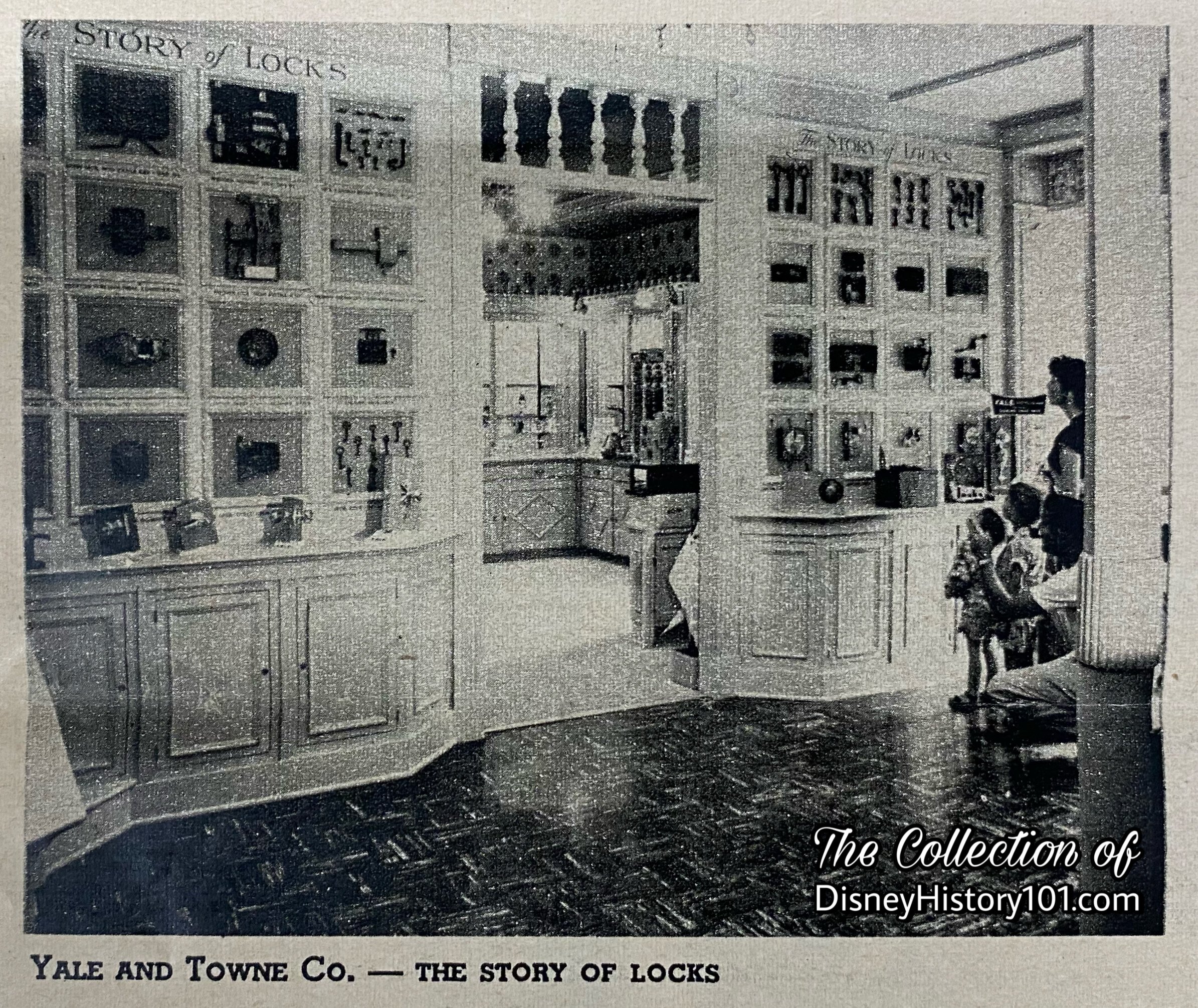
Above : “Disneyland 1st Anniversary Souvenir Pictorial.”
The same article of “The Disneyland News” continues:
“The Romans, improvers that they were, took elements of both earlier type locks and perfected the pin and tumbler lock, which used a more or less conventional type key. Keys that were actually used by the Romans - found in the ashes of the city that was Pompii - are on view here.
Medieval locks, such as the one that guarded a door in the famous German Trausemite Castle and dating from the 13th century, show the next major improvement in keys. This is the ‘warded’ type lock and key. This variety of lock, in use for several centuries until the development of the modern lock as patented by Linus Yale in 1861, was an intricate device that depended for its effect on the complexity of the pattern that could be worked into the design of the key.
One of the shop’s most interesting displays is an iron chest, forerunner of the modern day office safe. This specimen has a more romantic past than most of its type : the story is that it was in use on a pirate’s ship about the year 1700. Proof that honor among thieves was a chance thing is given by the fact that three keys are needed to gain access to the treasures it may have once contained. The captain and first and second mates carried keys, each one to one lock and the use of all three was necessary.”
As a “sidelight,” one of the best c.1956 interior images of Yale & Town Lock Shop can be found in "Homecoming - Destination Disneyland" by Carlene Thie with photos by Mel Kilpatrick. Considering all of these displays, it is easy to see why by the year 1958, the YALE Towne & Lock Shop was considered one of 15 free educational shows and exhibits at Disneyland.

"The Disneyland News Excerpt"
The Disneyland News columnists regularly divulged when a Disneyland Participant was featured in an advertising campaign in another periodical. Once, when “Yale & Towne’s Street Shop was the subject of a full page four-color advertisement in several of the country’s leading periodical publications during the month of May,” it was written that the “Saturday Evening Post and TIME were two of the magazines that carried the striking ad which showed the store’s exterior.”
Articles and columns like this are a prime example of “the possibilities for a sponsor to capitalize on this association” with Disneyland. The many ways of “merchandising, sales promotion, advertising, public relations and publicity programs are almost limitless. Regardless of the type of product, goods or services manufactured and marketed by sponsors, the Disneyland association can be effectively and importantly translated into the sponsor’s promotional activities,” according to “Disneyland, U.S.A.,” published 1958.
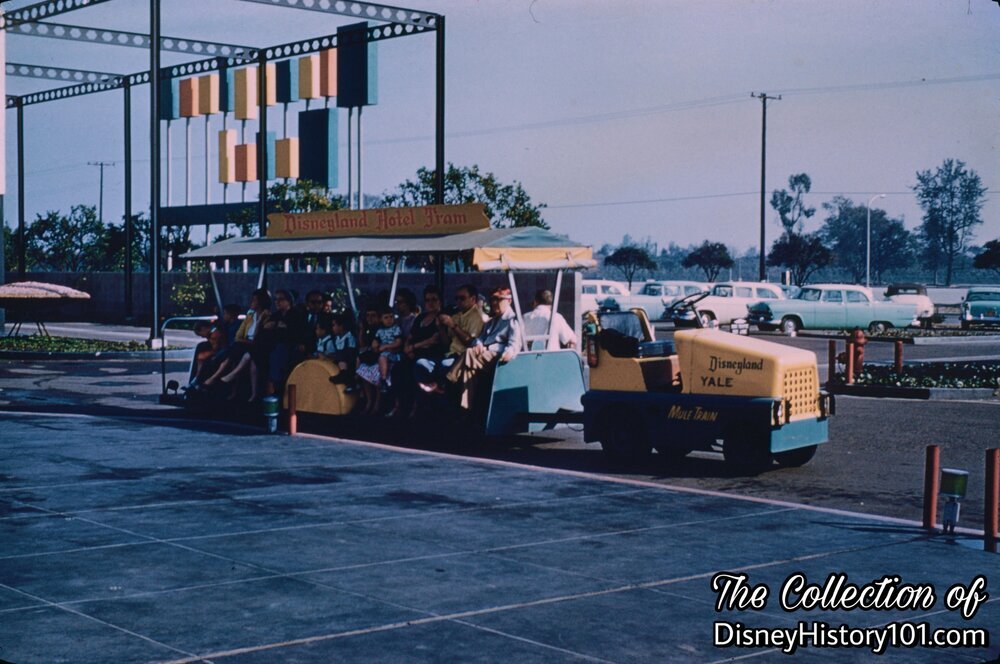
YALE Mule Train & Tractor
The Mule Trains - early tractors and trams - may have been designed by Bob Gurr, but they were manufactured by Yale. Yale was the very same manufacturer of the hydraulic YALE Forklifts used to swiftly transport cameras (situated atop platforms) for the Opening Day telecast. The Yale forklifts were powered by Chrysler Ind. 30 engines and could even maneuver cameras (and cameramen) to the height of forty feet in the air. More of these models were acquired on October 28, 1955 (at a cost of $4,527.40 and $4,363.26) to be utilized by both the Mill and Warehouse.
From 1955 to 1959, other forklift brands (e.g. Clark and Trojan) were purchased for use at both the Mill and Warehouse. However, Disneyland, Inc. also acquired a few YALE model G24 tractors (a total of 3 on July 29, 1955; valued at $1,250) to be utilized by the Warehouse and other locations.

YALE Mule Train & Tractor
Several of these “Mule Trains” and tractors can readily be seen preserved on film, in “Disneyland, U.S.A.” (a “People and Places” feature film, released in the U.S. on December 20, 1956 through Buena Vista Film Distribution Company). Brief footage of the original Mule Trains has also been amazingly preserved on film in the “An Adventure in the Magic Kingdom” episode of Walt Disney’s “Disneyland” television series (airing in 1958)!
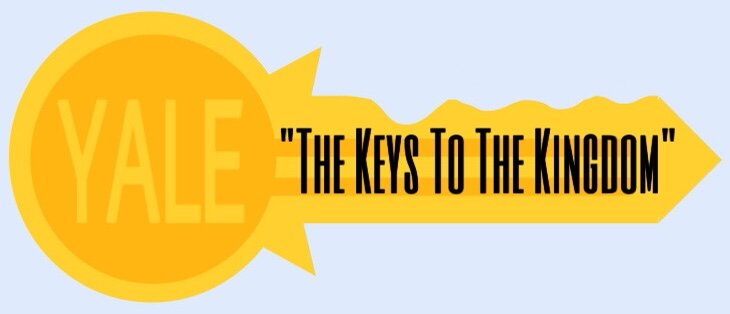
“I feel there is no door which with the kind of talent we have in our organization, could not be opened.” -Walt Disney.
While Disneyland occasionally made use of other brands (e.g. a $31 purchase from Kwikset Locks, Inc., during 1958), thousands of doors, locks, and plates with deadbolts installed around Disneyland (during the “first fabulous decade” and beyond) were manufactured by the Yale & Towne Manufacturing Company. These ranged from installation in Walt’s Firehouse Apartment to the Monsanto House of the Future and even the Haunted Mansion.
Before Disneyland opened, articles published in Pacific Coast Review and Printer’s Ink, mentioned that “Yale & Towne, lock shop… will give Disney a golden key that will open any lock in the park.“ Soon one Yale & Towne Manufacturing Company advertisement boasted : “Mr. Disney himself, like a magical Merlin, can open them all - many thousands of them - with a single Yale master key!”
This was further commented on in “Walt’s Master Key Opens All Magic Kingdom Doors” (published for guests in “The Disneyland News,” for November of 1955) : “One of the many wonders of Disneyland is a secret from the visiting public. This hidden wonder is the great grand master key system, created expressly by Yale & Towne locksmiths to provide the maximum in security and convenience in operating the thousands of locks that guard the Magic Kingdom’s valuable properties.
Within the ingenious key system only Walt Disney himself has the single ‘magic key.’ This is the grand master key that can open all of the thousands of different locks installed throughout the multi-million dollar funland.
This lone key is at the apex of the Yale master key system in which many thousands of locks are protecting both the public and Disneyland against loss or possible accident without interfering with the smooth operation of the par and its four major lands.
The unique master system begins with individual keys that can open only individual locks, continues to sub-master and grand master key levels, and all are unified by Walt’s single ‘magic’ key into a great grand master key system. This embraces all of the 160 acres of Disneyland, from the Turn-of-the-Centuy Main Street to Tomorrow and of 1986.
Watchmen, Maintenance and janitorial employees, however, who must service the shops, are assigned sub-master keys that will open the doors only on the blocks for which they are responsible. Thus Walt and his top aids don’t have to carry a pocket full of keys when visiting any part of Disneyland. His single key opens all the thousands of locks in the park.”
One of Walt’s “top aids,” Dorothy Wrigley (Walt’s Secretary, Park Operations Secretary & Disneyland’s 26th employee) helped set up (and regularly stock) Walt’s Main Street Apartment. This, Dorothy would do, before “Walt and Lilly would come to the Park to spend a few days in his apartment above the Fire Station,” according to “The Spirit of Disneyland” (published 1985, for Disneyland Cast Members). As with all of Disneyland’s c. 1955 keys, the special Yale Lock in the door accessing Walt’s Apartment could only be opened by a special Yale Key, which Walt (and evidently, Dorothy Wrigley) possessed.
You may recollect those “Day at Disneyland” Special Guest Cards which were once billed as “your ‘magic key’ that opens all the Doors in Walt Disney’s Magic Kingdom.” Perhaps Yale’s Master Key provided inspiration for this “tag line.”
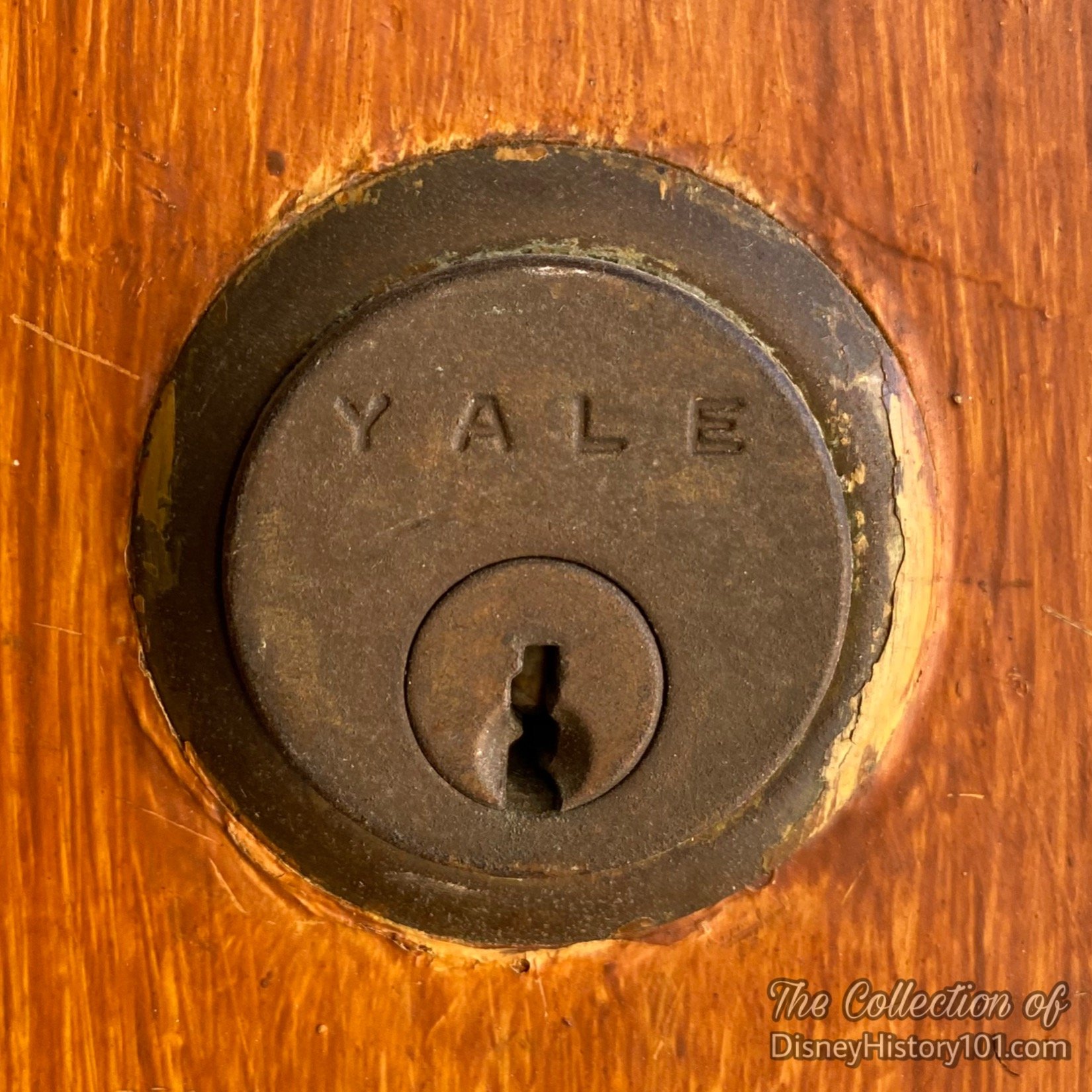
A YALE lock on a door of the Chicken of the Sea Pirate Ship Restaurant.
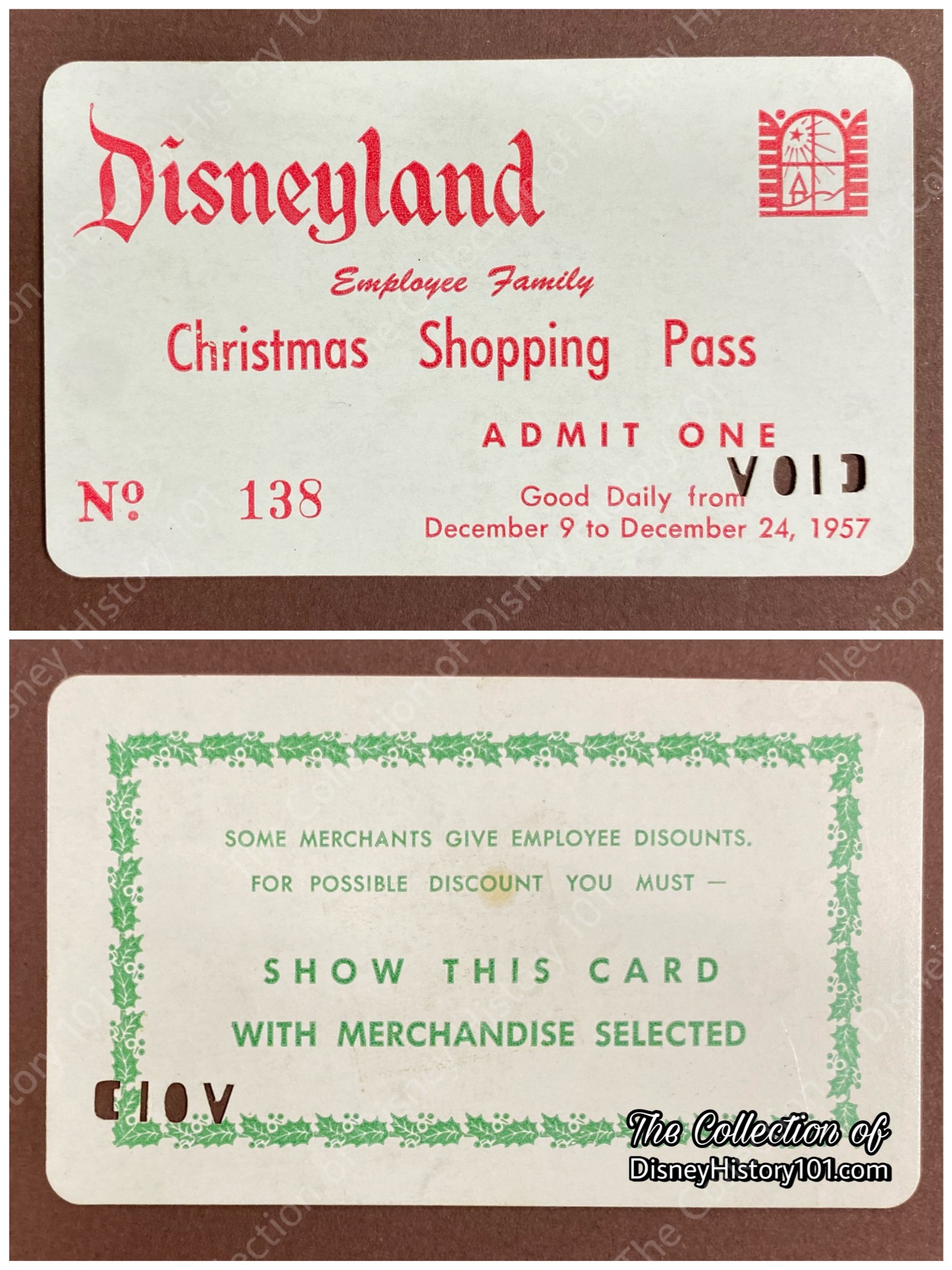
According to The Disneyland Shopper (published 1955): “Half the fun of buying Christmas Gifts is the atmosphere you shop in. You couldn't ask for more in the way of the spirit of Christmas than to shop in Disneyland. Especially along Main Street will you catch the air of the good old-fashioned Christmas with wreaths of holly, Christmas bells, carolers, snow-frosted windows gaily decorated with fairytale rhymes, and the scent of pine boughs in the air. Ringing through this Magic Kingdom are the Christmas Songs we all love to hear.”
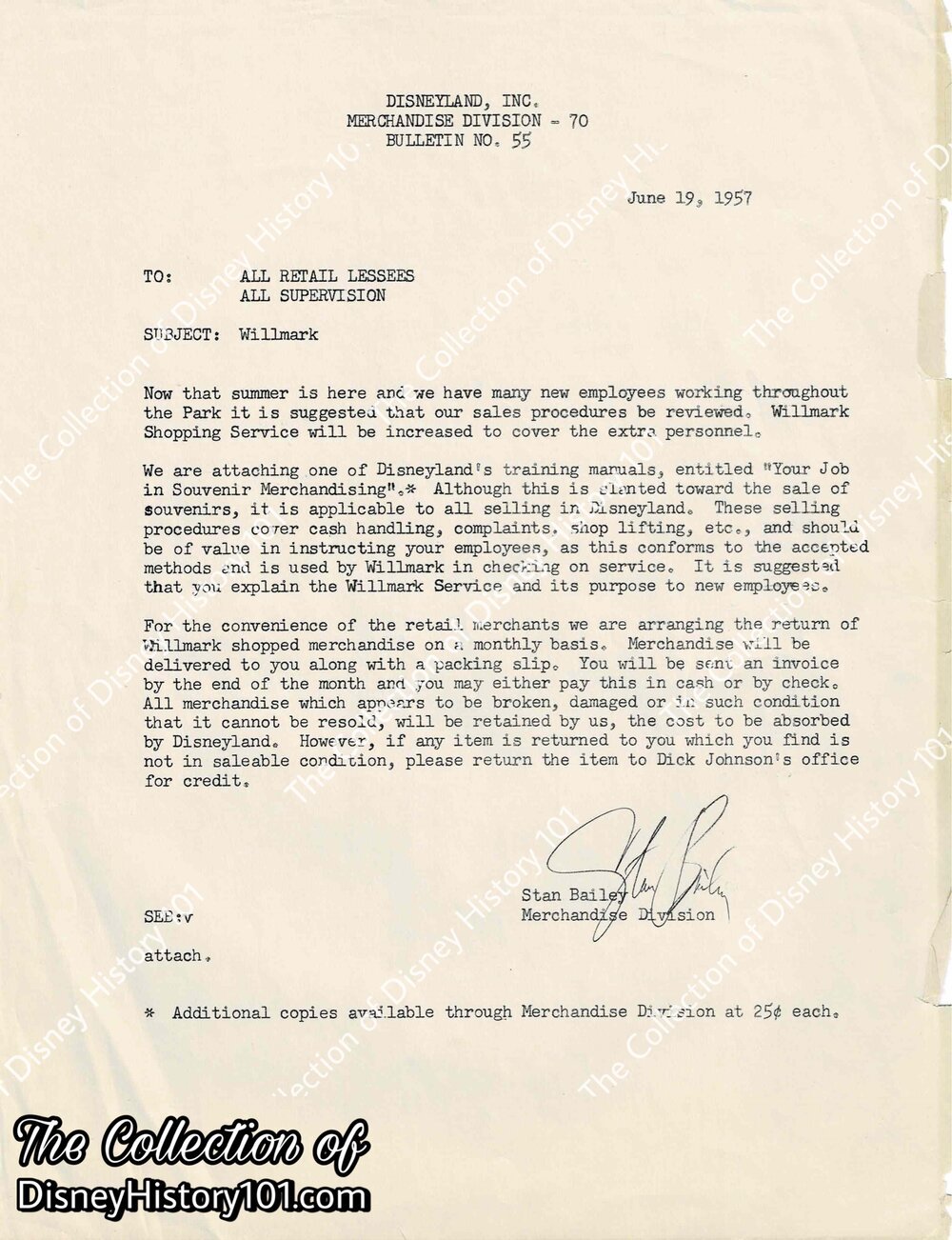
Disneyland, Inc. once utilized the Wilmark Shopping Service to assure higher levels of quality service in Souvenir Merchandising.
Yale Lock Shop created tangible memories for Guests through Merchandise and Show. The “Disneyland 1st Anniversary Souvenir Pictorial,” encouraged visitors to “browse through stores whose shelves bulge with worlds of distinctive merchandise.” The Yale Lock Shop was not exempt, and addition to the Disneyland Keys, offered many other souvenirs, like souvenir keys and locks, and door knockers, and tie clasps and key chains with key motif. According to one article published in “The Disneyland News” : “Also available at the store is a variety of novel lock and key jewelry, including souvenir padlock earrings, key tie-clasps and cuff links. [Of course] Yale & Towne’s line of modern locks, both beautiful and functional, are also on view here. Combination locks, locks deigned for special uses - such as telephone locks - and a cutaway model of the modern pin and tumbler lock round out the store’s stock of items.”
The 1957 TWA brochure “Let’s Talk About… My Visit to Disneyland, Anaheim, California: A Note from Mary Gordon TWA Travel Advisor” mentioned: “We learned that to fully explore Disneyland takes two days, so early next morning we were at the gates of the park again. The second day we spent more time shopping in the 50 inviting shops, and the youngsters bought inexpensive souvenirs to take home to friends.”

YALE Towne & Lock Shop Gold-Plated Souvenir Key and Disneyland Souvenir Box
Unlike the Upjohn Pharmacy exhibit, the Yale Lock Shop was not “merely a display store,” according to one article published in “The Disneyland News.” It offered a “practical key duplication service as part of the shop’s activity.” It is notable to mention that during these early years, it was commonplace for merchandise locations to stock General Merchandise - non -character and/or decorative items, including film and sundries.
Similar to other exhibits, souvenirs were made available. “These keys have a special Disneyland design showing the imprint of Sleeping Beauty’s Castle on the bow” and were “available only in the Main Street store.” All of these uncut keys were compatible with Yale home lock installations, and could thus be “cut” by your local locksmith. Advertisements for the “Souvenir Disneyland Key at the Yale Lock Shop” were run in issues of “The Disneyland News” (i.e. Vol.1, No.2 ; August, 1955).
These exclusive key “blanks” were routinely distributed as complimentary souvenirs over the years, and gifted on special occasions. For instance, Yale keys were given to invited members of the Press on Press Preview Day at Disneyland, on July 15, 1955. A special Yale “Key to Disneyland” was also presented to United States Vice President Richard Nixon by Fess Parker, on August 11, 1955.
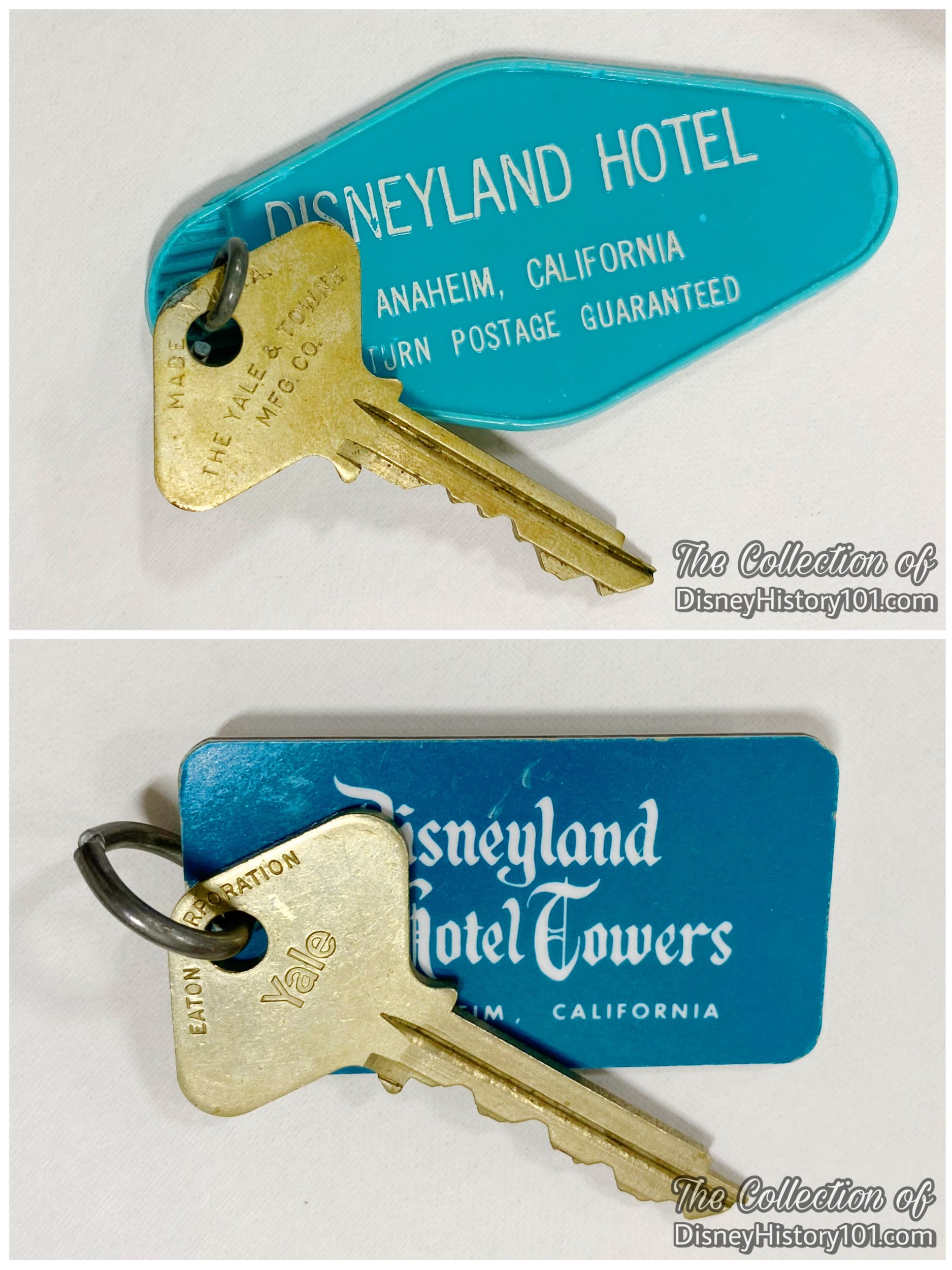
YALE Keys for the Disneyland Hotel & Disneyland Hotel Towers.
The Yale & Towne Manufacturing Company also first manufactured many of the keys for the locks belonging to the suites of the Disneyland Hotel. The Disneyland Hotel was distinguished from all other hotels on the west coast, in that its suites contained “the first installation of new Yale 5400 series cylindrical hotel locks.” The new knobs were “made of aluminum, strikingly finished with a satiny appearance,” and contained “internal parts of… brass and bronze for durability.” These locks also had the added privacy and safety feature of “a button in the center of the inside knob” which “causes two indicators to project from the center of the outside knob,” automatically locking the door and making it “impossible for the maid, housekeeper or even the manager with a master key to unlock the door from the outside… even other guest keys from the same room will not open the door.” However, the same article [of “The Disneyland News”] stated that, “For protection of guests, however, an emergency key is kept locked in the manager’s safe. The key will open the door to any room should a guest become incapacitated or other emergency occur.”

A SARGENT key for the Disneyland Hotel Towers.
While a few other manufacturers, like Sargent would later also provide locks and keys for the Disneyland Hotel, Yale & Towne Manufacturing Company first primarily provided this service for Disneyland and the Disneyland Hotel.
The corporate synergy was good for a time. Institutional lessee the Yale and Town Manufacturing Company yielded some revenue for Disneyland Inc. - $4,847 for the fiscal year ending September 29, 1957 and $6,580 (in addition to estimated $77 in accounts receivable) for the fiscal year ending September 28, 1958.
By October of 1959, the company was (1) of over sixty-eight other firms playing a vital part in the team effort to bring happiness to Disneyland’s Guests. Some were small, specialized individual operators; some were huge companies such as Swift & Co. - the Bank of America - United Paramount Theaters (which you hear as UPT) - Carnation - Richfield - General Dynamics - Crane - and many others. These companies used the park to publicize their wares, leased space in the Park to sell their wares, and Disneyland collected advertising fees from them.
The doors of Yale Town & Locke at Disneyland were closed and locked for the final time in 1964.
“Keys & Key Control”
Today Key Control assists with keys or lock maintenance.
